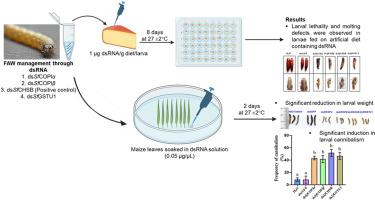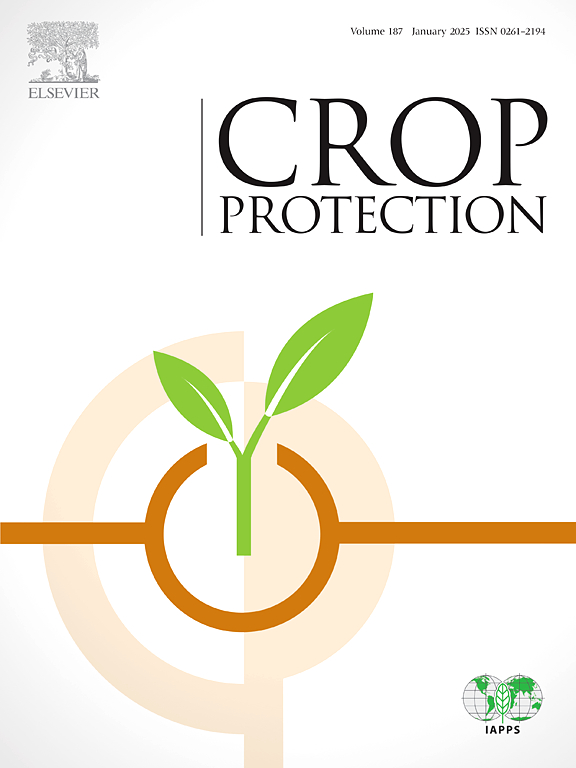鉴定以 RNAi 为介导的害虫--秋陆虫(Spodoptera frugiperda, J. E. Smith)--管理的新型靶基因
IF 2.5
2区 农林科学
Q1 AGRONOMY
引用次数: 0
摘要
对昆虫重要基因的 RNA 干扰(RNAi)是一种潜在的害虫定向管理工具。然而,如何选择合适的目标基因及其dsRNA递送方法也是一项挑战,因为已知不同昆虫物种的RNAi功效各不相同。秋陆虫(FAW;Spodoptera frugiperda)是一种多食性通翅目害虫,可取食 100 多种植物,对玉米有强烈的偏好。在本研究中,我们评估了三个重要基因的 RNAi 效能,这三个基因分别编码衣壳聚合物亚基α(COPIα)、衣壳聚合物亚基β(COPIβ)和谷胱甘肽-S-转移酶 U1(GSTU1),它们是治理 FAW 的潜在靶标。实时 PCR 分析表明,通过饮食连续口服这些靶基因 8 天后,FAW 幼虫体内靶基因的表达水平降低了 75-80%。它还导致幼虫(40-50%)和蛹(40-62%)大量死亡,并导致中间体(28-38%)和成虫(25-40%)畸形。它还影响繁殖,表现为产卵量减少约 50%。此外,在玉米叶片中外源施用 dsRNA 还能显著阻止 FAW 幼虫取食,从而提高食人的频率。目标基因dsRNA对FAW生物学和行为的影响表明其具有杀虫潜力。因此,目前的研究揭示了新的靶基因及其在基于 RNA 的杀虫剂中的应用,以实现对 FAW 的可持续管理。本文章由计算机程序翻译,如有差异,请以英文原文为准。

Identification of novel target genes for RNAi mediated management of the pest, Fall Armyworm (Spodoptera frugiperda, J. E. Smith)
RNA interference (RNAi) of vital insect genes is a potential tool for targeted pest management. However, the selection of the right target genes and its dsRNA delivery method is also a challenge because the RNAi efficacy is known to vary among insect species. Fall Armyworm (FAW; Spodoptera frugiperda) is a polyphagous generalist insect pest that can feed on more than 100 plant species, with a strong preference for maize. In the present study, we evaluated the RNAi efficiency of three vital genes coding for Coatomer Subunit alpha (COPIα), Coatomer Subunit beta (COPIβ) and Glutathione-S-transferase U1 (GSTU1) as potential targets for managing FAW. Real-time PCR analysis showed that the target genes' expression level reduced to 75–80% in FAW larvae, after their continuous oral delivery through diet for 8 days. It also caused significant mortality in larvae (40–50%) and pupae (40–62%), and resulted in deformed intermediates (28–38%) and adults (25–40%). It also affected reproduction as evidenced by an approximately 50% reduction in oviposition. Moreover, exogenous application of dsRNA in maize leaves resulted in significant feeding deterrence by FAW larvae, which enhanced the frequency of cannibalism. The impact of target genes’ dsRNA on the biology and behaviour of FAW suggests their insecticidal potential. Thus, the current study reveals the novel target genes and their utility in RNA based pesticides for sustainable management of FAW.
求助全文
通过发布文献求助,成功后即可免费获取论文全文。
去求助
来源期刊

Crop Protection
农林科学-农艺学
CiteScore
6.10
自引率
3.60%
发文量
200
审稿时长
29 days
期刊介绍:
The Editors of Crop Protection especially welcome papers describing an interdisciplinary approach showing how different control strategies can be integrated into practical pest management programs, covering high and low input agricultural systems worldwide. Crop Protection particularly emphasizes the practical aspects of control in the field and for protected crops, and includes work which may lead in the near future to more effective control. The journal does not duplicate the many existing excellent biological science journals, which deal mainly with the more fundamental aspects of plant pathology, applied zoology and weed science. Crop Protection covers all practical aspects of pest, disease and weed control, including the following topics:
-Abiotic damage-
Agronomic control methods-
Assessment of pest and disease damage-
Molecular methods for the detection and assessment of pests and diseases-
Biological control-
Biorational pesticides-
Control of animal pests of world crops-
Control of diseases of crop plants caused by microorganisms-
Control of weeds and integrated management-
Economic considerations-
Effects of plant growth regulators-
Environmental benefits of reduced pesticide use-
Environmental effects of pesticides-
Epidemiology of pests and diseases in relation to control-
GM Crops, and genetic engineering applications-
Importance and control of postharvest crop losses-
Integrated control-
Interrelationships and compatibility among different control strategies-
Invasive species as they relate to implications for crop protection-
Pesticide application methods-
Pest management-
Phytobiomes for pest and disease control-
Resistance management-
Sampling and monitoring schemes for diseases, nematodes, pests and weeds.
 求助内容:
求助内容: 应助结果提醒方式:
应助结果提醒方式:


